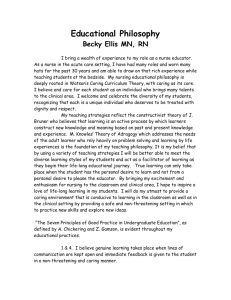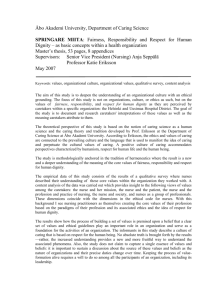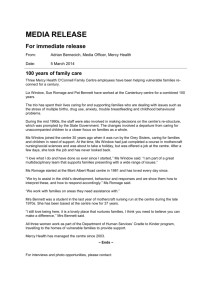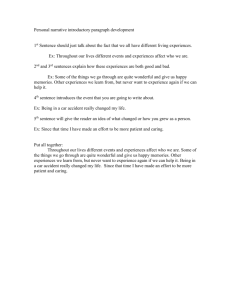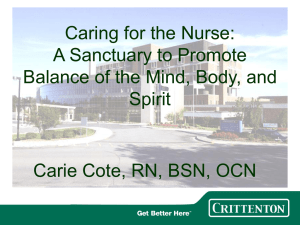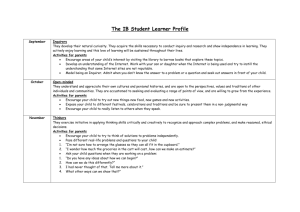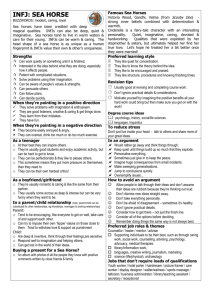Running Head: THEORY OF HUMAN CARING
advertisement
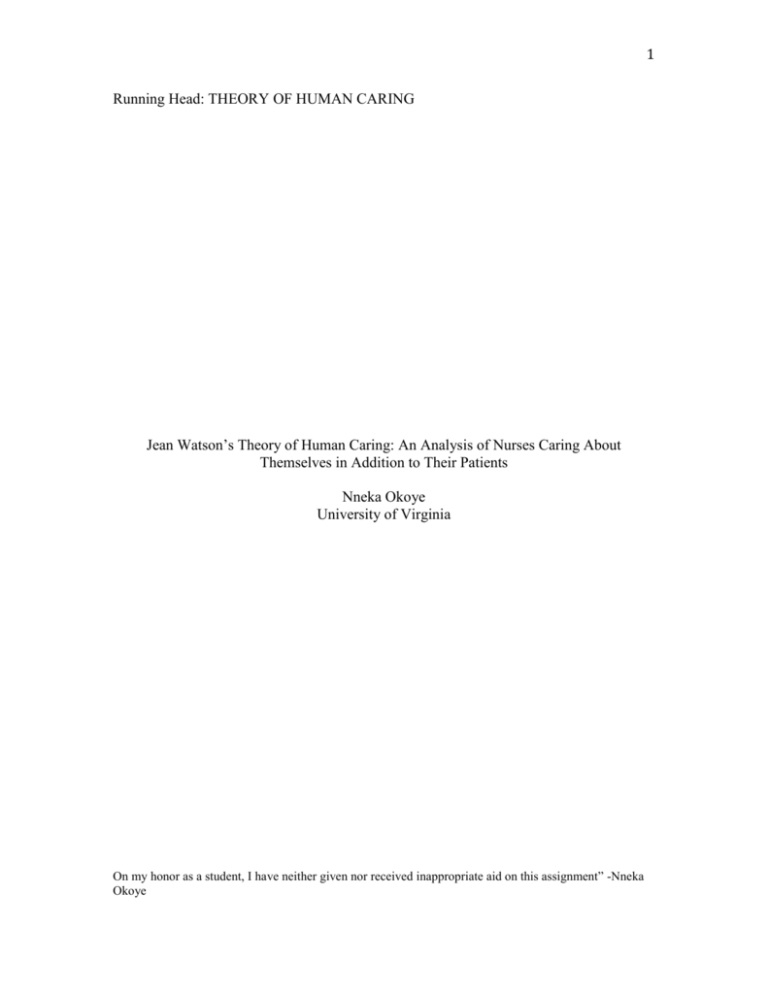
1 Running Head: THEORY OF HUMAN CARING Jean Watson’s Theory of Human Caring: An Analysis of Nurses Caring About Themselves in Addition to Their Patients Nneka Okoye University of Virginia On my honor as a student, I have neither given nor received inappropriate aid on this assignment” -Nneka Okoye 2 Abstract Jean Watson’s Theory of Nursing Care is a middle-range theory that focuses on the interconnectedness of patient and nurse. Nurses play a vital role in their patients’ life and by developing caring behaviors, they could facilitate healing. This theory also focuses on authentically caring about the whole patient and understanding the power of a meaningful therapeutic relationship. Watson believes caring about oneself is important and integral in a transpersonal relationship. The theory introduces clinical caritas process which help guide the nurse toward developing caring behaviors. They include general concepts of faith, trust, love, hope, caring, selflessness, spirituality, energy, and understanding. This theory is very significant to nursing practice and can be applicable to all fields of nursing. This paper will briefly elaborate Watson’s Theory of Human Caring and elucidate its strengths and weakness in the acute care setting. 3 Introduction Registered nurses in today’s society have come a long way since days of the Crimean War where Florence Nightingale set the standard on basic nursing care. Nurses in the 21st century have made significant strides in expanding their roles in healthcare making them extremely important in implementing high quality care. With more responsibilities, come less time to complete tasks. Nurses are busier than ever before and it can be difficult for them to connect with patients. Taking care of a patient seems like an obvious duty the nurse must fulfill, but really caring about the patient seems to get lost in gamut of nursing responsibilities. The assumption is nurses have an innate capability of caring, but it is surprising how many nurses may not know what it truly means to care for a patient or to develop a meaningful therapeutic relationship. This is especially true in an acute care facility where the focus is the bio-physical aspects of care. Jean Watson’s Theory of Human Caring gives nurses the tools to develop caring behaviors and reminds them that caring is important in the healing process. Nurses are deeply responsible for the lives of their patients and are the source of sustaining not only the humanity of their patients, but their own (Watson, 2008). In order to effectively care for others, nurses must also care about themselves. Watson emphasizes that as humans, we are morally obligated to truly care about people because we can effect others in ways that are unforseen. Understanding the metaphysical connection between humans can also help understand the importance of human caring. This theory is very significant to nursing practice and can be applicable to nursing in all settings. This paper will briefly elaborate Watson’s Theory of Human Caring and elucidate its strengths and weaknesses in the acute care setting. Watson’s Theory of Human Caring Jean Watson’s Theory of Human Caring is a middle range theory that contributes to the existential side of nursing. It focuses on authentically caring about the whole patient. This means caring about the patient’s mind, body and spirit so that the healing process can continue at an optimal level. Watson described it as a model of caring that includes both art and science; offering a framework that embraces and intersects with art, science, humanities, spirituality, and new dimensions of mind-body-spirit medicine as 4 well as nursing (Watson, 2009). Watson believes her theory is an evolving one and should be open to the ever-changing practice of nursing as well as to the dynamics of human phenomena. She elaborates by stating “caring science goes beyond an intellectualization of the topic, [it] invites us into a timeless; yet, timely space to revisit the perennial phenomenon of the human condition” (Watson, p. 58, 2008). Applying such abstract concepts of love, faith, caring, hope, trust, spirituality to nursing science can help stratify the concept of human caring. The Theory of Human Caring is comprised of 4 major conceptual elements: clinical caritas processes, transpersonal caring relationships, caring moment/caring occasion and caring (healing) consciousness. The clinical caritas processes emerges from Watson’s own caritas factors that involved the promotion of faith, trust, love, hope, caring, selflessness, spirituality, energy, and understanding. She uses the Greek word ‘caritas’ to mean something that is very fine and indeed precious, [invoking] love” (Watson, 2006, p. 297). She calls for these clinical caritas processes to be a guide used to practice this theory. 1. Practice of loving kindness and equanimity within context of caring consciousness. 2. Being authentically present, and enabling and sustaining the deep belief system and subjective life world of self and one being cared for. 3. Cultivation of one’s own spiritual practices and transpersonal self, going beyond ego self and opening to others with sensitivity and compassion. 4. Developing and sustaining a helping-trusting, authentic caring relationship. 5. Being present to, and supportive of, the expression of positive and negative feelings as a connection with deeper spirit of self and the one being cared for. 6. Creative use of self and all ways of knowing as part of the caring process; to engage in the artistry of caring-healing practices. 7. Engaging in genuine teaching-learning experience that attends to unity of being and meaning, attempting to stay within others’ frames of reference. 8. Creating a healing environment at all levels (physical as well as non-physical), a subtle environment of energy and consciousness, whereby wholeness, beauty, comfort, dignity, and peace are potentiated. 9. Assisting with gratification of human needs, with an intentional caring consciousness, administering “human care essentials,” which potentiate alignment of mind-body-spirit, wholeness, and unity of being in all aspects of care; tending to both the embodied spirit and evolving spiritual emergence. 10. Opening and attending to spiritual-mysterious and existential dimensions of one’s own life-death; soul care for self and the one-being-cared-for. (Watson, 2006, p. 298). 5 This guide is supposed to help a nurse toward implementing caring behaviors into their own nursing practice. A transpersonal caring relationship is said by Watson to “move beyond ego self and radiate to spiritual, even cosmic, concerns and connections that tap into healing possibilities and potentials” (Watson, 2006, p. 299). Nurses must find it within themselves to explore and reflect on who they are in order to provide optimal care. If the nurse is in touch with what it takes to care about their patient, it may take them on an experience that not only benefits the patient, but the nurse. The nurse transcends their duty by anticipating the needs of the patient and seeing to it that those needs are met. Caring moment/caring occasion focuses on the moment the nurse experiences something greater than themselves. It may feel spiritual and cause the nurse to make connections to others that were never there. It can also mean being present for the patient or in the moment leaving room to open up new possibilities for a human connection at a deeper level than that of physical interaction (Watson, 2006). The function of caring/healing consciousness means the nurse must be aware of the dynamics of life and human phenomena. Watson wants the nurse to know that every human being is connected and the energy exuded by the nurse can effect how a patient heals. She moves towards a more existential path by stating “caring-healing-loving consciousness exists through and transcends time and space and can be dominant over physical dimensions” (Watson, 2006, p. 301). This part of the theory is very subjective and can be hard to explicate. The Theory of Human Caring presents itself with many strong elements and attributes, but it also has its limitations. Authors Chinn & Kramer (2008) provide a guide to help one critically examine this theory. 6 1. How clear is this theory? 2. How simple is this theory? 3. How general is this theory? 4. How accessible is this theory? 5. How important is this theory? According to Chinn & Kramer (2008) addressing these questions help decipher how well developed a theory is and/or how adequate how well a theory serves its purpose. These questions will be answered to help effectively evaluate this theory. Theory Strengths Clarity Watson’s praxis lends itself to providing another dimension of nursing that rarely is explored, the art of caring. Developing this theory stratifies the concept of caring. Caring is an important part of nursing and Watson facilitates the nurse to understand the power of human caring. Reading this theory, it is clear states patient care can be a cosmic ordeal that leads to a profound healing process for the patient and caring occasion for the nurse. In an acute care setting, patients can be consumed by anxiety and fear. It takes a caring nurse to identify those symptoms and help the patient resolve it. A prospective, descriptive study implicated if nurses try to know their patients through the transpersonal caring relationship element of the theory, they are more likely to identify and manage their patients’ needs (Pipe, Kelly, LeBrun, Schmidt, Atherton & Robinson, 2008). The structural clarity and consistency of the theory helps to mostly understand its unfamiliar concepts outside of nursing. Simplicity Most of the relationships described in the model of caring are described strongly. The relationship described between patients and nurse is intensely deep and interconnected in the eyes of Watson. A great deal of the theoretical basis for nursing 7 practice is grounded in the transpersonal relationship that regards the patient as the cherished other, the participant in the caring moment can be a vehicle for healing on many levels (Watson, 1999). This is dependent on the general concept that patients often rely on nurses for psychosocial, spiritual care and comfort. The relationship possesses great healing power for patient because Watson believes in the interconnectedness of human beings. The caring model provides a capacity for nurses to understand how caring behaviors can help develop transpersonal relationships with patients, putting them at ease and promoting a sense of security. This theory is significant in helping nurses develop these caring behaviors. Accessibility The concept of caring is very broad, but Watson’s Theory of Human Caring seems to help stratify the concepts to help nurses understand more about human caring. Definitions within the theory are general enough to make the theory easy to follow. The theory did introduce a new word and defines it accordingly. The term “caritas” is defined in her theory. She proclaims it comes from the Greek word meaning “to cherish and appreciate, giving special attention to, or loving” (Watson, 2006). Importance It is important to understand that Watson developed this theory to be an everevolving work in progress; therefore, it has transcended and adapted to our rapidly changing society and nursing practice. It responds very well to the dynamics of human phenomena. It focuses on nurse self-care which one can appreciate. Watson wants the nurse to understand that one must find their inner and spiritual self helps to go beyond ego self so as to initiate opening oneself to others with sensitivity and compassion. 8 It also has a tremendous potential to influence nursing actions and propel the discipline further into a more holistic context. According to Hernandez (2009) self-care is important in nursing because it brings nurses closer to their spirits, allowing them to feel interconnectedness with all there is in the world and to experience a cosmic love. Hernandez echoes one of the tenets of Watson’s theory by saying the nurse should take of themselves first before others. One can apply this knowledge and others to their nursing practice because tasks as simple as “being present” can be done in any setting, especially the acute care setting. In the hustle and bustle of a hospital, the nurse can bring daily awareness to their practice through the practice of mindful breathing; every time the nurse enters the patient’s room, the nurse can take a cleansing breath that reminds them to be aware of the present moment (Hernandez, 2009). “Cultivating breath awareness brings balance to our thinking, feeling and doing” (Hernandez, 2009, p.130). Use of this theory should not hinder nursing in any way; although, there is currently minimal research to measure and validate outcomes. This theory is contains concepts that seems to enhance the discipline of nursing. Theory Limitations Simplicity The empiricism of this theory might get lost on those who cannot grasp a hold of to the metaphysical and philosophical nature of it. McCance explicates “the philosophical context on which the theory is based may lead to difficulties in understanding for individuals who have no background knowledge in this area” (McCance, 2009, p. 1394). Some of the concepts are broad enough that much of it can be very subjective lending 9 itself to misinterpretation. Some of the concepts might be a little too vague and overlap and could cause confusion. Importance A significant problem for this middle range theory is that it lacks research. Studies to help reinforce the theory are very minimal. More research is needed to help measure desired outcomes. Although, the theory concepts seem sound, it must be challenged. For some nurses, the theory could be looked on as meaningless. McCance (1999) wrote the existential-phenomenological-spiritual forces used by Watson may be meaningless to many nurses working in clinical practice reinforcing the fact that more research is needed. Conclusion Jean Watson’s Theory of Human Caring helps nurses to develop caring behaviors, reminding them the act of caring is an extremely important part in the healing process. The theory has many strong elements and qualities such as the ability to transcend the ever-evolving dynamics of human phenomena. The relationship between patient and nurse can intense and must be repected because holds the key to creating a cosmic experience. Watson emphasizes that as humans, we must take care of ourselves in order to take care of others. Understanding the metaphysical connection between humans can also help understand the importance of human caring. More research needs to be conducted on this theory to validate its usage in nursing practice. This model of caring is seemingly well developed in theory, but lacks development in practice due lack of empirical studies. 10 References Chinn, P. & Kramer, M. (2008). Integrated theory and knowledge development in nursing. St. Louis: Mosby-Elsevier Hernandez, G. (2009). The heart of self-C.A.R.I.N.G.: A journey to becoming an optimal healing presence to ourselves and our patients. Creative Nursing. 15(3). McCance, T., McKenna, H., & Boore, J. (1999). Caring: theoretical perspectives of relevance to nursing. Journal of Advanced Nursing, 30(6), 1388-1395. Pipe, T., Kelly, A., LeBrun, G., Schmidt, D., Atherton, P., Robinson, C. (2008). A prospective, descriptive study exploring hope, spiritual well-being and quality of life in hospitalized patients. MEDSURG Nursing. 17(2). Watson, J. (1999). Postmodern nursing and beyond. New York: Harcourt-Brace Watson, J. (2006). Jean Watson: Theory of human caring (Ed.). In Parker, M., Nursing theories and nursing practice. (2nd ed., p. 295-307). Philadelphia: F.A. Davis Company. Watson, J. (2008). Social justice and human caring: A model of caring sciences as a hopeful paradigm for moral justice for humanity. Creative Nursing. 14(2). Watson, J. (2009). Caring Science 10 Carita Processes: The implications of caring theory. http://www.watsoncaringscience.org/caring_science/theory.html

